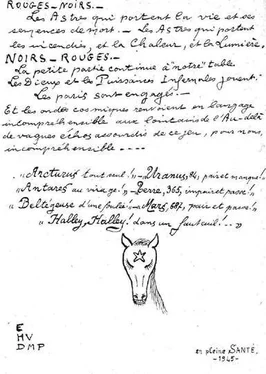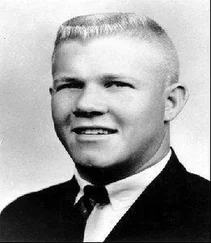As Massu already knew, Petiot and Nézondet had often dined together in their bachelor days in Yonne. They had been arrested together, twenty years later, by the Gestapo. In between, Nézondet had left his position as a clerk after injuring his arm. He started breeding trout and growing watercress at a ranch outside of Villeneuve-sur-Yonne. He also operated a restaurant and entertainment center, La Fontaine-Rouge. The Petiots liked to attend his Saturday night dances, invariably on Georgette’s urging. Marcel Petiot hated dancing.
By 1936, after the end of his first marriage and losing his investment in a fire, Nézondet had moved to Paris and begun working as a concierge for Le Figaro . He had started to see Petiot again after consulting him for a throat condition that developed in the First World War. Nézondet was also in a new relationship with a nurse at Hôpital Cochin named Aimée Lesage, and they soon began to dine often with the Petiots. The Nazi Occupation, however, prompted Le Figaro to move to Lyon; Nézondet followed, only to be sacked shortly afterward for his alleged black market dealings. In 1942, he had returned to Paris and reconnected a third time with Petiot. It was his old friend who helped him obtain a job with the father of one of Petiot’s patients, Victor Braun, who ran a pharmaceutical company that sold many supplies to the German army.
An inspector observing Nézondet told Massu beforehand that he would probably prove a difficult interviewee, likely to tense up at the least provocation and force the commissaire to have to draw out each monosyllabic reply. Massu, thus warned, began slowly. He walked behind the suspect without saying a word. He stood there, still silent, at his cabinet, pretending to search through papers. Nézondet remained tense. His raised shoulders, Massu noted, had not moved.
The inspector was right about Nézondet’s lack of candor. When Massu asked if he liked his friend Petiot, Nézondet did not answer. When he asked about his line of work, Nézondet was evasive. Massu, tiring of the charade, pressed a button and told the secretary who entered the room to watch the witness. He went for a drink at a nearby bistro on the place de Dauphine. Nézondet was left, as he put it, “to simmer.”
An hour and a half later, when he returned, Massu asked Nézondet again about his relationship with Dr. Petiot. This time, Nézondet spoke of his friend’s love of art, furniture, and deal making. For instance, sometime last spring, Petiot had asked him to offer his boss the opportunity to buy “1000 to 2000 bottles of cognac,” which he in turn could sell to the German army. Braun had declined because the military had stopped making bulk purchases of alcohol. What an interesting proposition from a so-called member of the Resistance.
Massu then asked Nézondet about the claims of the trucking company owner and secondhand furniture dealer Roland Porchon—namely, that he had seen sixteen bodies at rue Le Sueur. Nézondet dismissed this allegation with a laugh. It was outrageous, he said. He had not seen any bodies personally; Porchon must have been mistaken. He had merely reported what someone else had told him. Who was that? Nézondet stalled and hedged, before finally admitting that the source of the information was Maurice Petiot. On March 22, after many evasions and denials, he said that he would now tell the truth.
In late 1943, either November or December, Nézondet began, he met Maurice Petiot at the Hôtel Alicot to negotiate the purchase of radio equipment. Petiot arrived an hour late and nervous unlike any time Nézondet could remember. He looked as “white as a sheet,” Nézondet said.
“I have just come from my brother’s house,” Maurice allegedly told him. “There’s enough there to have us all shot.”
“Enough what? Hidden weapons? A secret radio transmitter?”
“I wish that’s all it was. The journeys [to South America] begin and end at the rue Le Sueur.”
At this time, with Petiot still held in prison by the Germans, Maurice had also discovered “a pit full of bodies and quicklime—all of them were naked, with hair and eyebrows shaved off.” A book was found nearby, containing the names and addresses of all the victims, along with the dates and other notes about the executions. He found a syringe, a hypodermic needle, poison, and many bodies. “There must have been fifty to sixty victims.” Maurice also allegedly found a great deal of clothing, including suits, dresses, and German military uniforms.
Nézondet had been astonished, he told Massu, claiming that it was not possible, that “it’s a nightmare!” But Maurice’s demeanor seemed to confirm the horrors. Nézondet noted how his hands quivered as he related his discovery.
What’s more, according to Nézondet, Maurice Petiot proceeded to describe the means of execution as some sort of distance-operated syringe. The victim, locked in the triangular room, would eventually press a button in the wall, which activated the lethal device. A miniature needle hidden inside the button pricked the finger with poison. That way, Petiot had not technically killed his victims; they had done it to themselves.
“Why did you not inform the police?” Massu asked. “It’s your duty.” The Law of 25 October 1941 had established the legal obligation to denounce a crime or the intent to commit a crime. The failure to comply carried a penalty of three months to five years in prison.
“I know that well,” Nézondet said. “But Marcel Petiot was my best friend. I also thought of his wife and his son.”
Commissaire Massu asked how much Georgette Petiot knew of her husband’s activities. After a slight hesitation, Nézondet said that she knew everything because, as he feared for her safety, he had told her “the horrible truth” himself. In early January 1944, a few weeks after his meeting with Maurice Petiot, he had invited Georgette and Gérard Petiot to dinner at his apartment at 15 rue Pauly. They had discussed her husband, who she was sure would soon be released by the Germans, as indeed he was. Nézondet waited until the two of them were away from the teenager. As Nézondet put it, she “fainted, or almost fainted three times and threatened to commit suicide.”
Georgette Petiot would later confirm that the events that evening were substantially true as Nézondet described them. She added, however, that she had not believed a word of his story. He seemed to be lying. In addition, Nézondet had suggested that she should divorce her murderous husband and the two of them have an affair, and this, she told Massu, further convinced her that he had made up everything to seduce her. (Nézondet countered unconvincingly that he only said she needed to have an affair, though not necessarily with him.)
Maurice had been furious at him, Nézondet said, for telling Georgette about the dead bodies. The last he heard, Maurice was trying to figure out what to do about them, and also find a truck to haul away the many suitcases he’d found at his brother’s property.
Since that initial conversation at the Hôtel Alicot, Nézondet said that he had lived in mortal fear of his former friend. Not long after the physician’s release from the Germans, which Nézondet said had astonished him, Marcel Petiot invited him to rue Le Sueur. He politely declined, but when the physician, with his charm, refused to take no for an answer, Nézondet had relented. It was his lover, Aimée Lesage, who put a stop to the meeting, insisting that he never go to rue Le Sueur alone. She was certain, she believed, that she had saved his life.
THE French police continued to question neighbors of the reclusive physician. Augusta Debarre, a thirty-nine-year-old woman who lived on the third floor of 22 rue Le Sueur, had some information for the detectives. About nine or nine thirty one night the previous summer, Debarre had seen an old truck, probably a Ford, parked outside Dr. Petiot’s building across the street, and a couple of men had loaded a number of suitcases into it.
Читать дальше












